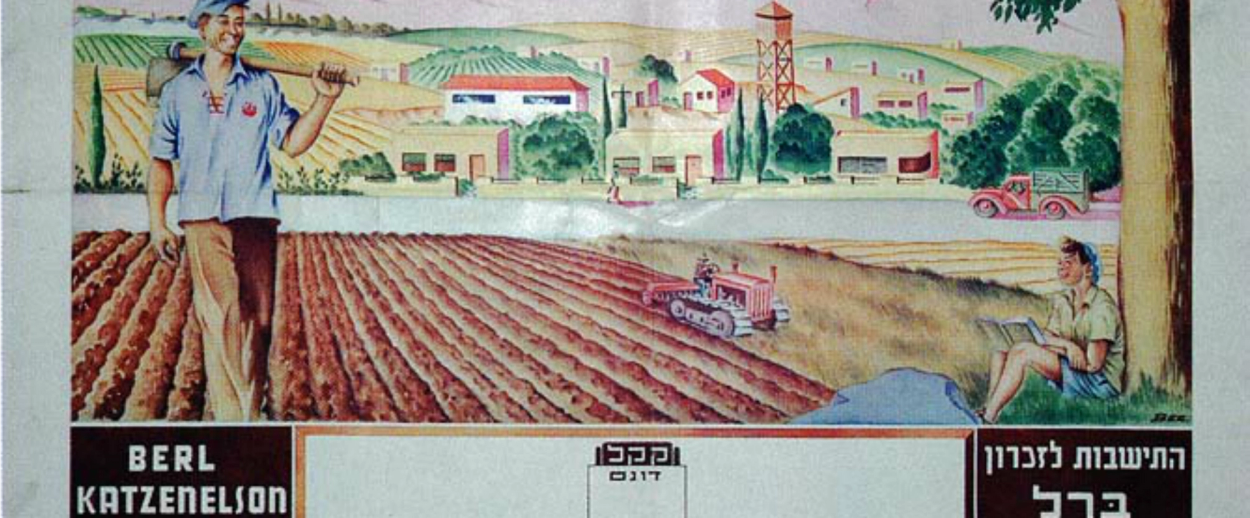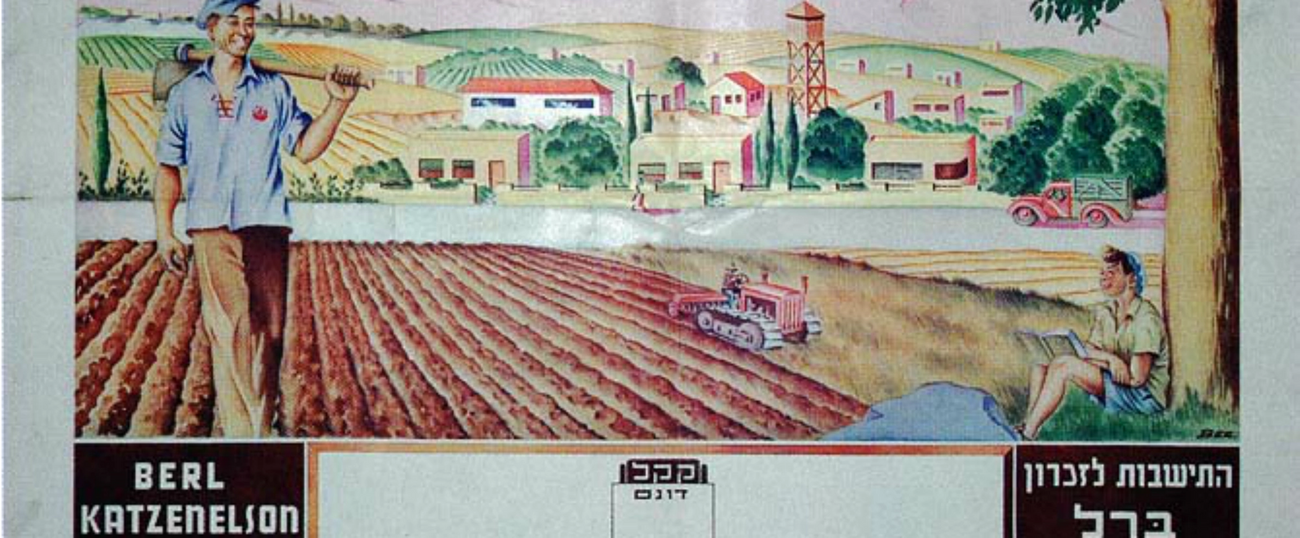Welcoming Zionist Ideas Into the Sukkah, Day 1
For every day of Sukkot, we’ll provide a text by a different Zionist pioneer. Today’s excerpt comes from Berl Katzenelson’s ‘Revolution and Tradition’




In the tension between the ephemeral and the eternal. We build flimsy huts through which we can see the stars, to symbolize how transient life can be. Yet, typically, we Jews have turned this lesson in evanescence into a lasting tradition. This paradox is a central Zionist tension, which the founder of modern Zionism, Theodor Herzl, captured in his novel Altneuland (Old-New Land), spurring homeless Jews to erect a modern state on our ancient homeland.
For every day of Sukkot, we will provide a text from Gil Troy’s newest book, an update of Arthur Hertzberg’s classic Zionist anthology, The Zionist Idea. Troy titled his update, The Zionist Ideas, to open the conversation, from right to left, religious to secular, traditional to modern. He organizes the book into three defining periods: Pioneers until 1948, Builders from 1948 until 1998, and Torchbearers–modern Zionists. In each time period, he identifies six schools of thought whose ideas echo in all these essays: Political Zionism, Labor Zionism, Revisionist Zionism, Religious Zionism, Cultural Zionism, and Diaspora Zionism. Since April, thousands of people have participated in Zionist Salons, reading these texts, developing their Zionist Ideas.
Day 1: Tradition and change — An excerpt from “Revolution and Tradition” by Berl Katzenelson (1887–1944)
(A note on spelling: though the current standard spelling is ‘Katznelson’ we are using ‘Katzenelson’ with the additional ‘e’ because that is how Hertzberg rendered it in ‘The Zionist Idea.’ ed.)
***
“A renewing and creative generation does not throw the cultural heritage of ages into the dustbin. It examines and scrutinizes, accepts and rejects.”
Immigrants to Palestine of “the Second Aliyah,” born in Russia in the 1880s, quickly became the leaders of the new Zionist settlement, called the Yishuv. The movement these mostly socialist Zionists fashioned dominated the government of Israel throughout the first decades of its existence. David Ben-Gurion and Yitzhak Ben-Zvi became its highest officers.
Berl Katzenelson was their contemporary and, until his death in 1944, a central figure of Socialist Zionism. While still an adolescent in Bobruisk, the White Russian city of his birth, he entered the whirlpool of ideologies and parties that was then the predominant concern of advanced young Russian Jews. Always a lover of the Hebrew language and emotionally a Zionist, he nonetheless wandered among the parties of the left for a few years without committing to any particular doctrine. After turning twenty he decided to go to Palestine and prepared himself in several skills, including blacksmithing.
In 1909, at age twenty-two, he arrived in Jaffa. Like the older A. D. Gordon and his near contemporary Joseph Hayyim Brenner, who became his friends, Katzenelson started his life in Palestine as a day laborer on the farm—and a labor organizer. He led a strike, founded a traveling library for farm workers, helped create a labor exchange for newcomers, and wrote frequently for the periodicals of the Labor Zionist movement.
During World War I, Katzenelson remained in Palestine. When the British army conquered its southern part, he enlisted in 1918 in its newly formed battalion of Palestinian Jews. After 1920 he became a front-rank official of Palestinian Jewry and the World Zionist movement. He remained consistently at the center of Labor Zionist affairs and spoke frequently before international bodies and Jewish communities abroad until his death in Jerusalem in 1944.
Katzenelson’s major importance, however, was not in politics, but in journalism and cultural affairs. In 1925 he founded the Tel Aviv newspaper Davar as the organ of the trade union organizations, the Histadrut. He remained its editor until his death. Am Oved, the publishing house of the Histadrut, was also his creation; indeed, he influenced the entire cultural program of Palestinian labor.
In this essay, Katzenelson’s Cultural Zionism – focusing on Jewish identity and renewal – comes across more strongly than his Labor Zionism. He tackles not just a central Zionist tension, not just a defining Jewish debate, but a compelling human dilemma: how much do we remember, preserve, revere from the past — and how much must we change?
An Excerpt From Berl Katzenelson’s Revolution and Tradition (1934)
We like to call ourselves rebels—but may I ask, “What are we rebelling against?” Is it only against the “traditions of our fathers”? If so, we are carrying coals to Newcastle. Too many of our predecessors did just that. Our rebellion is also a revolt against many rebellions that preceded ours. We have rebelled against the worship of diplomas among our intelligentsia. We have rebelled against rootlessness and middlemanship, and not only in the forms in which they appeared in the older Jewish way of life; we have rebelled against their modern version as well, against the middlemanship and rootlessness of some of the modern Jewish nationalist and internationalist intellectuals, which we find even more disgusting than all the earlier manifestations of these diseases. We have rebelled against the assimilationist utopia of the older Jewish socialist intelligentsia. We have rebelled against the servility and cultural poverty of the Bund. We are still faced with the task of training our youth to rebel against “servility within the revolution” in all its forms—beginning with those Jews who were so much the slaves of the Russian Revolution that they even distributed proclamations calling for pogroms in the name of the revolution, and including the Palestinian Communist Party of our day, which is acting in alliance with the pogromists of Hebron and Safed.
There are many who think of our revolution in a much too simple and primitive manner. Let us destroy the old world entirely, let us burn all the treasures that it accumulated throughout the ages, and let us start anew—like newborn babes! There is daring and force of protest in this approach. Indeed, there really were many revolutionaries who thus pictured the days of the Messiah. But it is doubtful whether this conception, which proceeds in utter innocence to renounce the heritage of the ages and proposes to start building the world from the ground up, really is revolutionary and progressive, or whether there is implicit within it a deeply sinister reactionary force. History tells of more than one old world that was destroyed, but what appeared upon the ruins was not better worlds, but absolute barbarism. . . .
People are endowed with two faculties—memory and forgetfulness. We cannot live without both. Were only memory to exist, then we would be crushed under its burden. We would become slaves to our memories, to our ancestors. Our physiognomy would then be a mere copy of preceding generations. And were we ruled entirely by forgetfulness, what place would there be for culture, science, self-consciousness, spiritual life? Arch-conservatism tries to deprive us of our faculty of forgetting, and pseudo-revolutionism regards each remembrance of the past as the “enemy.” But had humanity not preserved the memory of its great achievements, noble aspirations, periods of bloom, heroic efforts, and strivings for liberation, then no revolutionary movement would have been possible. The human race would have stagnated in eternal poverty, ignorance, and slavery.
Primitive revolutionism, which believes that ruthless destruction is the perfect cure for all social ills, reminds one, in many of its manifestations, of the growing child who demonstrates his mastery of things and curiosity about their structure by breaking his toys.
A renewing and creative generation does not throw the cultural heritage of ages into the dustbin. It examines and scrutinizes, accepts and rejects. At times it may keep and add to an accepted tradition. At times it descends into ruined grottoes to excavate and remove the dust from that which had lain in forgetfulness, in order to resuscitate old traditions which have the power to stimulate the spirit of the generation of renewal. If a people possesses something old and profound, which can educate man and train him for his future tasks, is it truly revolutionary to despise it and become estranged from it?
The Jewish year is studded with days which, in depth of meaning, are unparalleled among other peoples. Is it advantageous—is it a goal—for the Jewish labor movement to waste the potential value stored within them? The assimilationists shied away from our Jewish holidays as obstacles on the road to their submergence among the majority because they were ashamed of anything which would identify them as a distinct group—but why must we carry on their tradition? Did not bourgeois assimilationism and Enlightenment, and even the Jewish socialism which followed in their wake, discard many valuable elements of social uplift which are contained in our tradition? If we really are Zionist Socialists, it does not befit us to behave like dumb animals following every stupid tradition, just because it calls itself “modern” and is not hallowed by age. We must determine the value of the present and of the past with our own eyes and examine them from the viewpoint of our vital needs, from the viewpoint of progress toward our own future.
Let us take a few examples: Passover. A nation has, for thousands of years, been commemorating the day of its exodus from the house of bondage. Throughout all the pain of enslavement and despotism, of inquisition, forced conversion, and massacre, the Jewish people has carried in its heart the yearning for freedom and has given this craving a folk expression which includes every soul in Israel, every single downtrodden, pauperized soul! . . . I know no literary creation which can evoke a greater hatred of slavery and love of freedom than the story of the bondage and the exodus from Egypt. I know of no other remembrance of the past that is so entirely a symbol of our present and future as the “memory of the exodus from Egypt.”
And Tishah b’Av. Many nations are enslaved, and many have even experienced exile. . . . Israel knew how to preserve the day of its mourning, the date of its loss of freedom from oblivion. . . . Our national memory was able, with these very simple means, to make every Jewish soul, all over the world, feel heavy mourning at the same day and the same hour. . . .
I am not setting specific rules as to the form our holidays should assume. Suitable forms will grow from a living feeling within the heart and an upright and independent spirit. . . . As long as Israel is dispersed and is prey to persecution and hatred, to contempt and to forced conversion, as in Yemen in Asia, Algiers in Africa, and Germany in Europe—or even though they enjoy emancipation purchased through assimilation in capitalistic France and communistic Russia—I shall never forget, I shall never be able to forget, the most fearful day in our destiny—the day of our destruction.
Professor Gil Troy, a Senior Fellow in Zionist Thought at the JPPI, the global think tank of the Jewish people, is an American presidential historian, and, most recently, the editor of the three-volume set Theodor Herzl: Zionist Writings, the inaugural publication of The Library of the Jewish People.